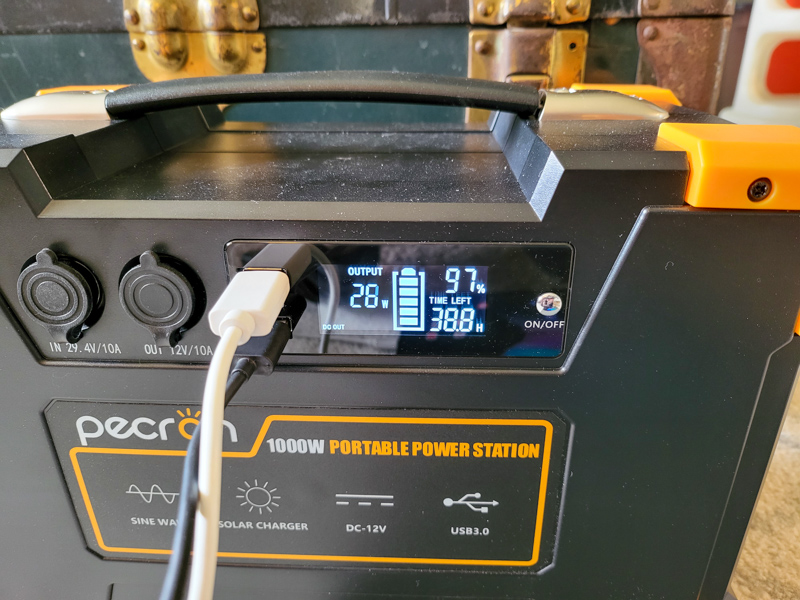
REVIEW – I’ve reviewed a handful of portable (and semi-portable) power stations over the years, and there are a couple of things I look for in a good power station now: good battery-to-price ratio ($1 per watt-hour of battery capacity has been the average going rate for a few years now), an informative display that indicates the time remaining at current usage levels (or time until fully charged), and enough output ports to run my various gadgets at a campsite or remote location or in case of a power outage. For all of these scenarios, the ability to attach a decent solar panel array to recharge during the day creates a nice off-the-grid experience, though previously the solar panels I’ve tested haven’t been able to generate enough power during the day to keep everything I’d want going overnight. The PECRON E1000 Portable Power Station might just tick off all my wants, at least on paper.
What is it?
The PECRON E1000 Portable Power Station is basically a portable battery, capable of providing power to multiple devices through both AC and DC power standards (like 120V AC outlets and USB or DC 12 volt sockets). It can be charged from a regular wall outlet or via connected solar panels. Speaking of, PECRON included their AURORA200 Portable solar panel system for me to test for this review, which can generate up to 200 watts of electricity in ideal sunlight conditions.
What’s in the box?
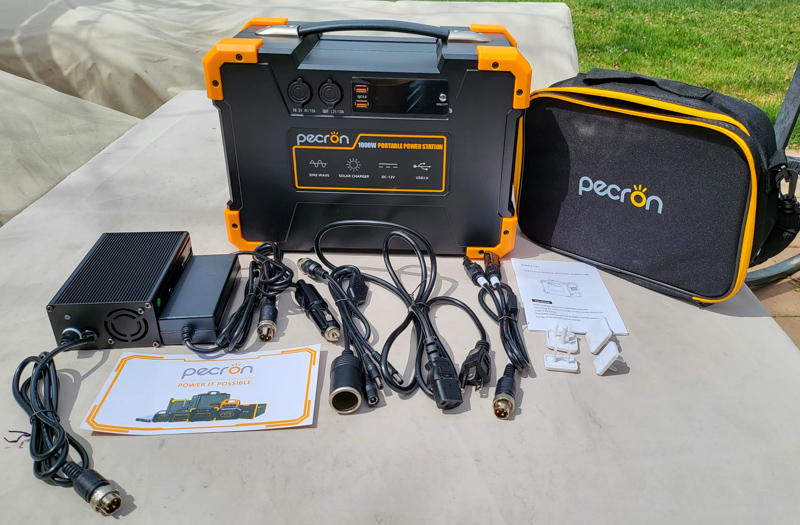
- PECRON E1000 Portable Power Station
- Accessory bag
- AC power supply for charging
- DC power supply for charging
- 4 core aviation connector to MC4 solar connector
- “4 in 1” cable
Hardware specs
- Charging time: 5-6 hours from wall AC adaptor or 400 watts of solar power (two of the Aurora200 systems with a Y combiner for example)
- PV input: 29.4-40V, 20A maximum
- Charging Type:AC Charging(DC29.4V9A);Solar Charging(Voltage 36V); Car Charging
- AC Output: AC220V/50Hz or AC110V/60Hz(Pure sine wave)
- Output Power: Rated Power 1500W; Peak Power 3000W
- DC Output: DC12V10A(Two Core Aviation Connector); QC3.0
- Battery Capacity: (25.2V40.8Ah)
- Battery: Li-ion(70%@1000 Cycles)
- Product Dimension: L13.5” x W7” x H9.75”(L340×W175×H250mm)
- Net Weight: 24.4lbs
- Aurora200 Portable Solar Panel: up to 200 Watts generated at 36V
Design and features
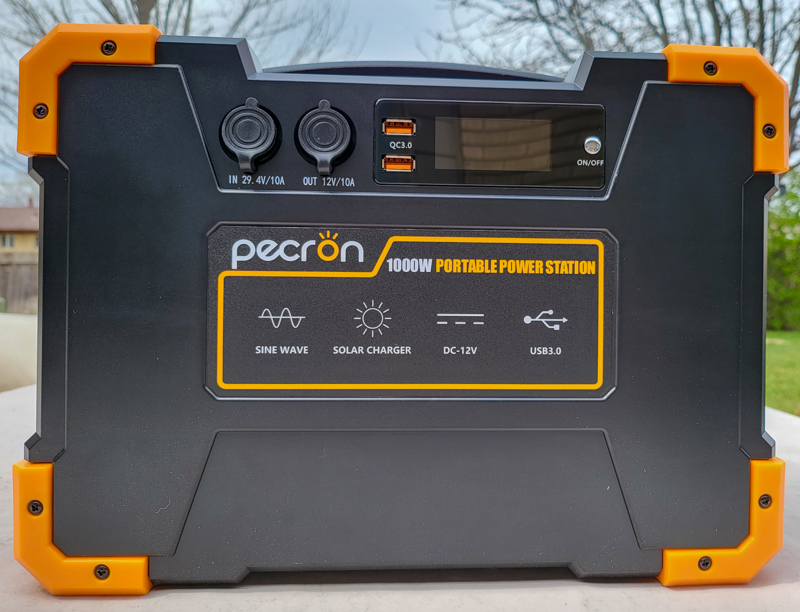
The front of the PECRON E1000 Portable Power Station sports a monochrome LCD screen that is easily readable even in bright sunlight. Two USB-A ports, an On/Off switch (for all of the front ports), a DC input and a DC output port are available here.
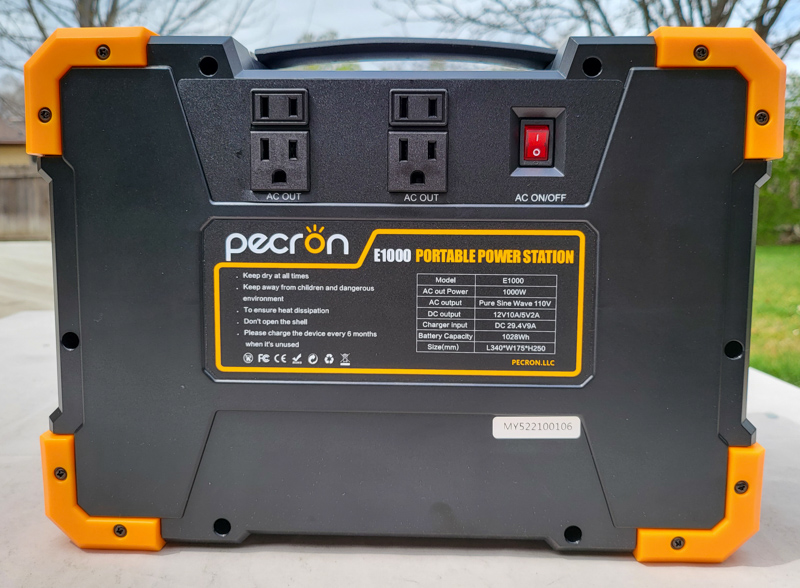
The four AC ports are on the back, along with the physical AC On/Off switch. There are two 3-prong (grounded) and two 2-prong (ungrounded) style outlets. Pecron rates the total AC output at 1000 watts sustained / 2000 watts peak pure sine wave power.
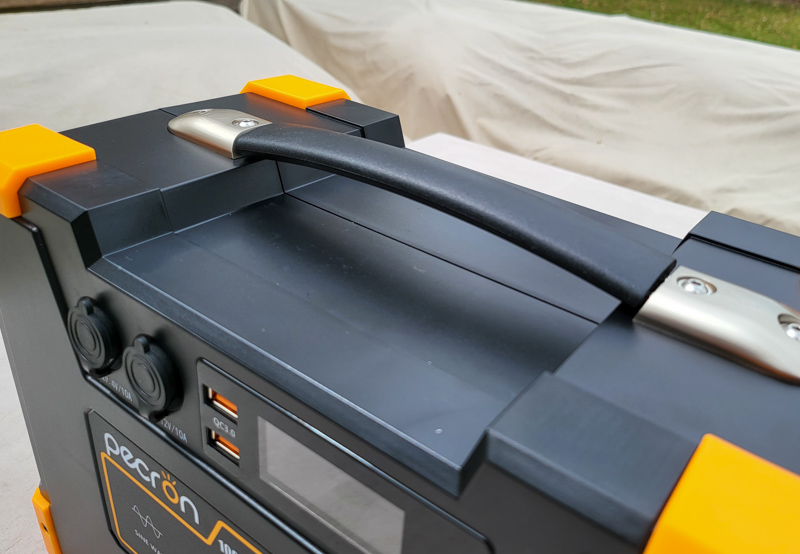
The handle seems quite sturdy, I had no fears of this breaking when transporting the unit around. Large thick plastic bumpers on every corner also lend to a sturdy-feeling build.
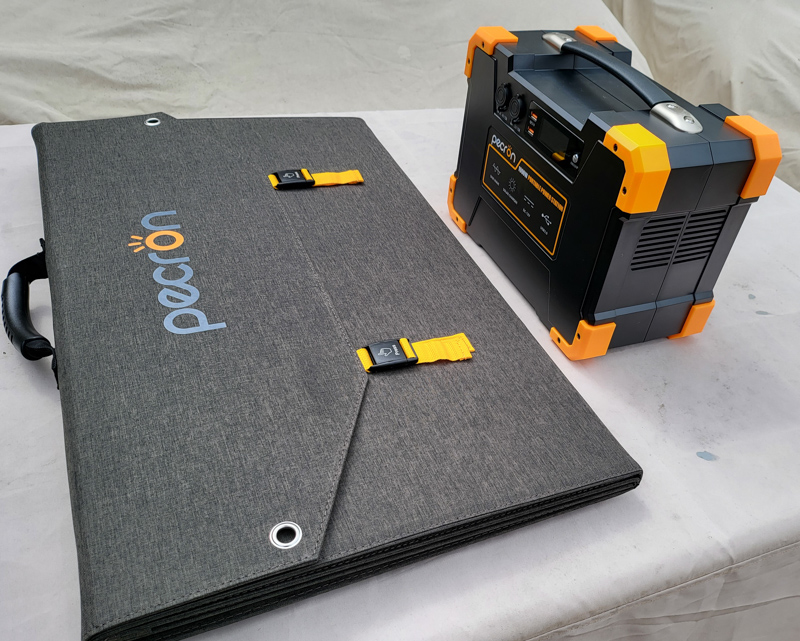
The Aurora200 portable solar panel (not included with the E1000 power station) is about as large as I can comfortably carry, and I’m a fairly big guy. PECRON has a couple of solar panel options, and the E1000 power station can accept different solar panels (though you’ll likely need to source adaptors since this is the first I’ve run across with a 4-pin aviation style connection).

An included accessory pouch also gives on the Aurora200 gives access to the output connections.
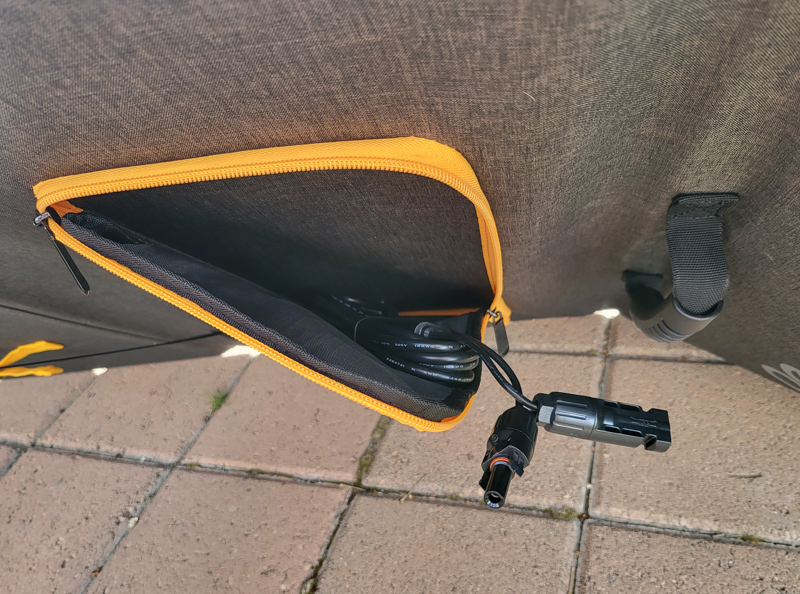
An adaptor was included that converts these plugs to a single 4-pin aviation input that screws into the E1000 power station.
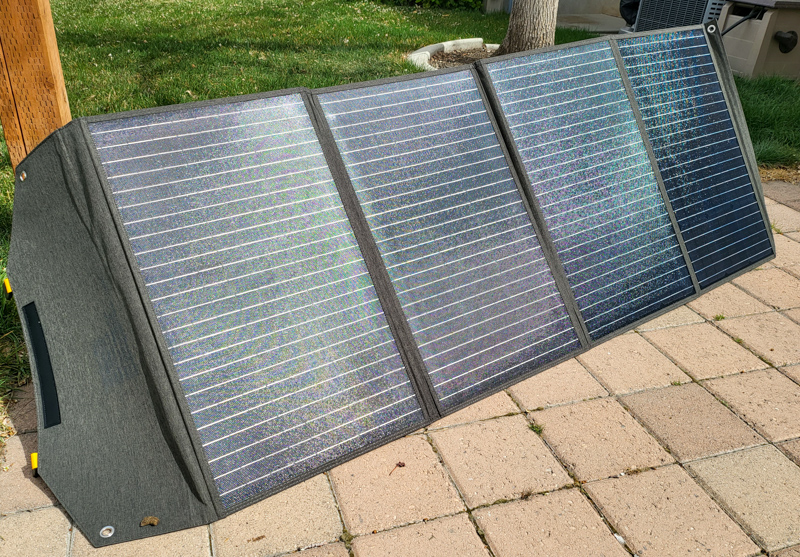
It unfolds to expose 4 light-gulping panels capable of putting out 200 watts of power to the power station. Slats on the back allow for the unit to rest at an angle.
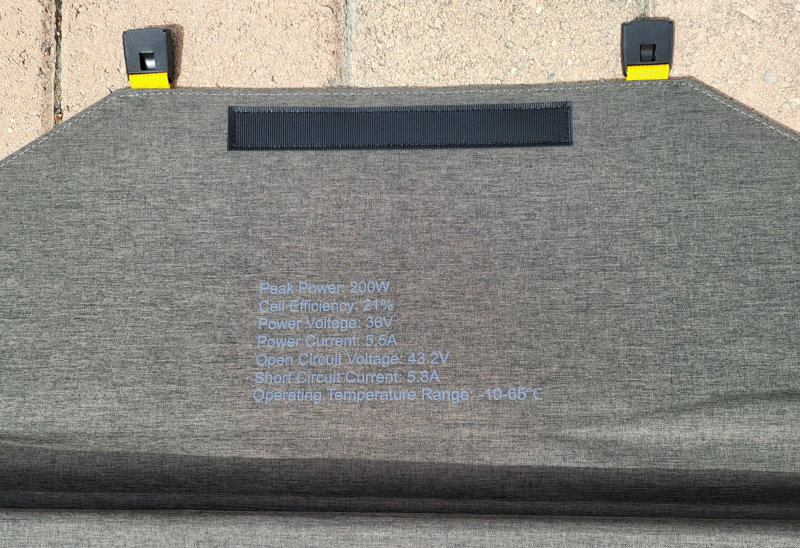
Stats are printed right on the flap of the Aurora200, including operating temperatures from below freezing to Death Valley heat levels.
Performance
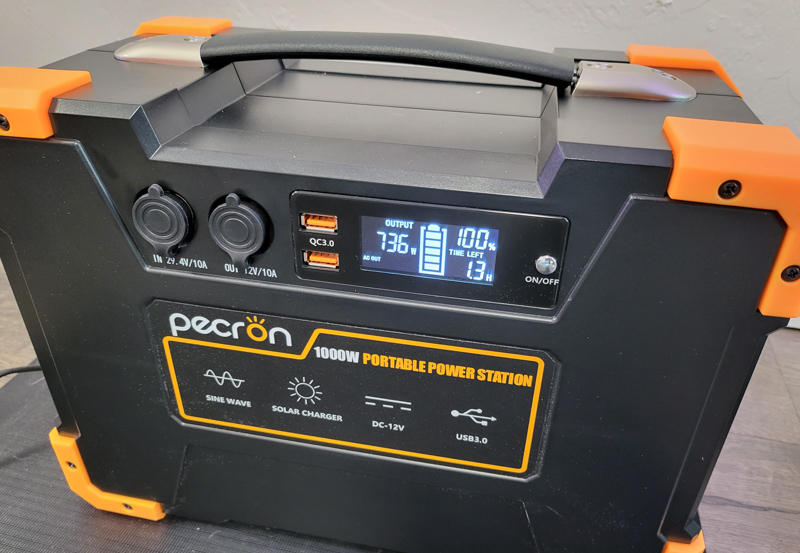
My favorite thing to test first with power stations is my office space heater. This unit spikes to near 1500 watts when starting, then stabilizes to ~740 watts sustained, which the PECRON E1000 handled easily. As you can see above, pushing this much power would drain the entire unit in just over an hour. By comparison, a 100-watt projector could run for about 10 hours, or a small fridge/freezer for 20+.
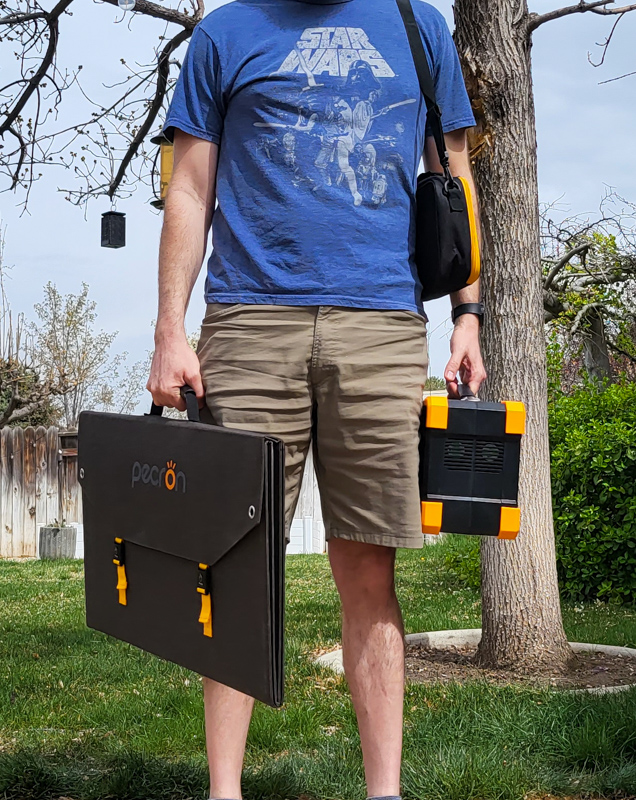
I then took the E1000 Portable Power station and Aurora200 Portable Solar panel outside, and as you can see the handles and shoulder sling for the accessories bag allows for one-person carry of the entire system. I wouldn’t want to hike very far with everything, but it’s convenient enough for short walks to different locations.
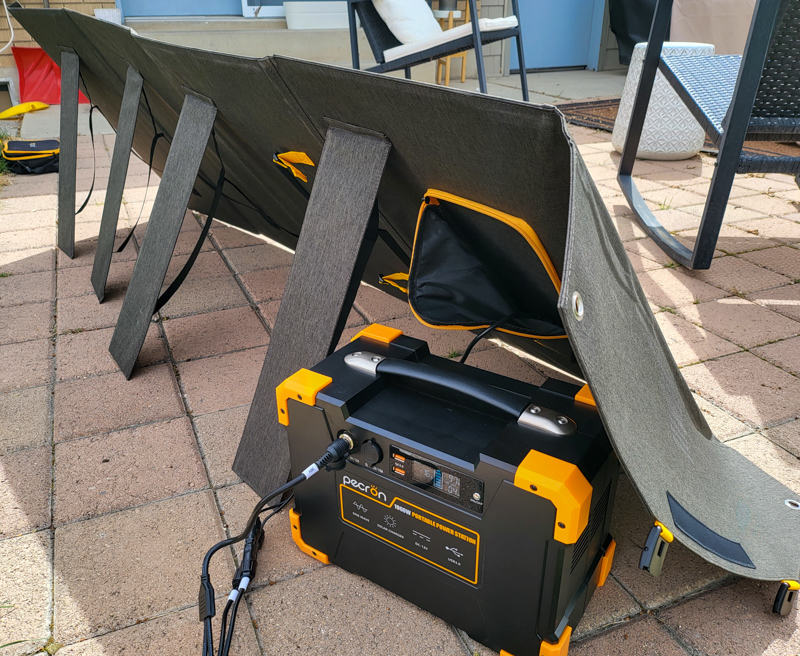
Connecting the Aurora200 Portable Solar panel to the E1000 Portable Power station was quick and easy.
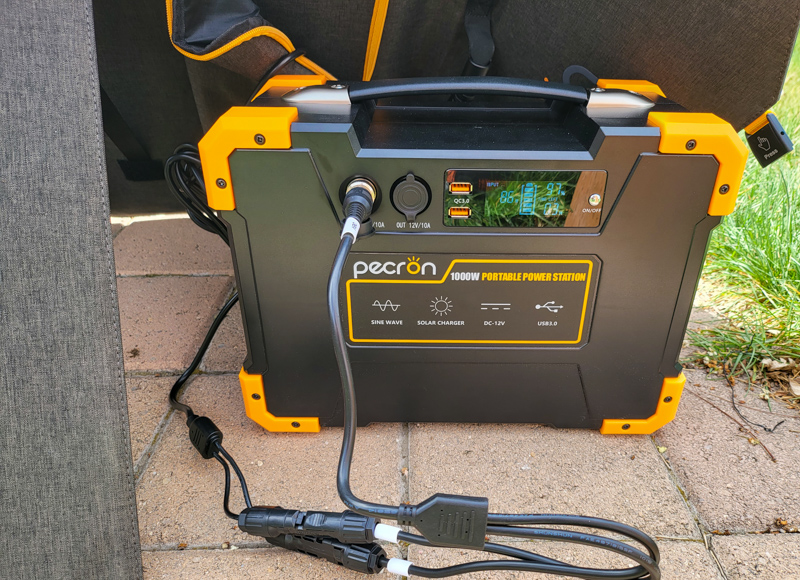
Even in early spring on a partly cloudy day, the Aurora200 was pushing 90+ watts of power to the E1000 power station. On anything but the shortest and cloudiest days, this combo should provide a nice overnight power supply, great for RVs/small cabins/power-outages.
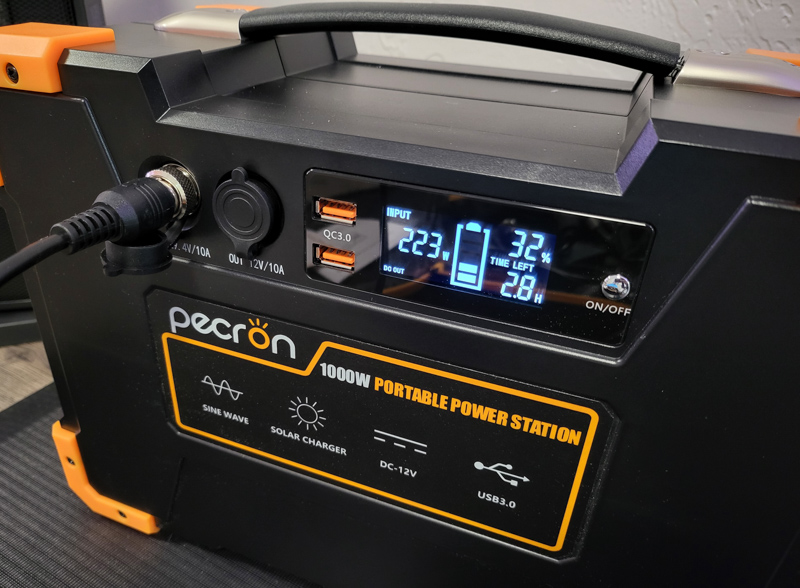
When plugged into the wall (or if weather conditions were better), the PECRON E1000 can accept up to 400 watts of power input, charging it up to full in 4-6 hours depending on input.
What I like
- Large capacity in a still-portable size
- Easy to read and informative LCD screen, including time-to-full/empty
- Excellent solar panel performance on the Aurora200
What I’d change
- Quieter cooling fans
- LED lantern feature
- USB-C Power Delivery
Final thoughts
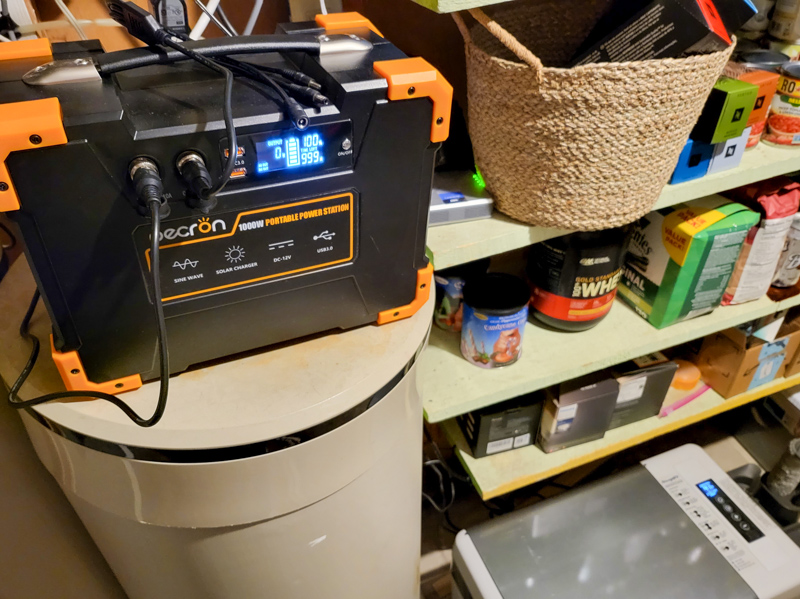
The Pecron E1000 Portable Power Station has earned a permanent spot powering my essential networking gear and a backup fridge/freezer in case of power outages (unlike some other units I’ve reviewed, it can both charge and be charged simultaneously). If we ever have a sustained outage or decide to bring it on outdoor adventures, I love that the Aurora200 solar panels will be able to recharge it on all but the cloudiest days. This 1000 watt-hour size power station is perfect for our needs, and is now an essential piece of our disaster preparedness plans and future camping adventures.
Price: $699 (Power Station) and $449 (Solar Panel)
Where to buy: Pecron E1000 Portable Power Station and Pecron Aurora200 Portable Solar panel and Amazon
Source: The sample for this review was provided by Pecron



Gadgeteer Comment Policy - Please read before commenting
Not that you are the only one, and not that I even know that much about solar, but I do know simple math. Under the stats you say 1500 watt output and 3000 watt peak, but then later. Say 1000 watt sustained and 2000 watt peak. Also, you say 200 watt solar panels , and conecting 2 of them for 400 watts charges the battery in 5- 6 hours, then later say 4- 6 hours, but simple math is 400 watts x 5 hours = 2000 watts ,not 1000 watts. Like I said, you are not the only one, and I am not trying to insult. I am trying to understand. Why does the math never seem to work out properly with solar power. I know about the 10% loss in power for not squeaky clean panels. I know about the 10- 20 % loss in power for the maybe not exact placement with sun ratio. I know about the 1- 99 % power loss for how cloudy it can be. I am saying that so many articles say that it takes 400 watts( standard) to charge a 1000 watt battery in 4- 5, 5- 6, even as much as 6-8 hours in good sunlight. Why???? 8 hours at 400 watts peak( clean panels, pointed ditectly at the sun, on a cloudless day) should be 3200 watts, not 1000 watts. And if a company is advertising a product, you would give the best case scenario or better(the lies all manufactures tell) not the average or worst case scenarios. If your 200 watt panel only produces 100 watts of power, then call it a 100 watt panel. If there is a 50- 70% power loss in charging a battery vs direct usage, then say that. Which brings me to my next question. If I use the solar panels to directy feed my equipment vs charging a battery first, willI then get the full 400 watts of power directly, or is that power cut by 50- 70 percent right off the bat also??? Please dont think I am insulting. Again, I am just trying to understand, and am looking for some real answers vs the well maybe this and maybe that answers that still do not add up. You dont advertise off of maybe this and maybe that. Please respond kindly. Thanks.
Ron – good questions and observations.
On the rated power, those manufacturer specs I get from their product page and copy/paste over into my article. In this case, it looks like their specs page is different than the product packaging/manual. I would count on the lower of two ratings when they have mismatched ratings here. From my testing, it does handle peak surges around 1500 watts (my heater turning on at low setting, but you don’t want to run a combined wattage over 1000 for any period of time, the “peak” wattage quoted is just for some types of electrical appliances that surge when started then settle down to a lower power level.
On the charging/solar/watts question, again I believe this is coming from different numbers on their website, but you also have to take into account battery chemistry. As someone who drives an electric car with Lithium Ion batteries, the charge time from 0% to 50% is wildly different than 50% to 100% (10-15 mins for first scenario, sometimes 30+ for the second). As Lithium Ion batteries near their full capacity, the charge rate goes down dramatically. I’m not an electrical engineer or chemist, there’s smarter people that could explain the why here.
On the solar panel question with the set they gave me, the best sunlight I was able to test during this review period was far from ideal (early spring with mostly cloudy days). Getting almost 100 watts out of the system in these subpar conditions was pretty impressive to me after testing several solar panel sets. If you were running this combo on a hot summer day, I’m pretty sure it would be getting 150-200 watts. If you were also running things off the power station while simultaneously getting solar input, your charge/discharge math would change (if you were putting out 150 watts constant and getting 150 watts in from the solar, overall charge level would remain the same).
Due to the large battery capacity, it was hard during testing to get it fully depleted and then fully charged again, but ETA from near dead to full on the AC wall adaptor was reading at 5 hours estimated.
thanks alot of information keren
Does the e1000 pecron have a mppt controller installed ? I can’t charge a 100 watt solar panel with it. Thanks
I don’t see anything about an MPPT controller on their website or in the manual, I’d reach out to them directly but I’m guessing it doesn’t have one since it’s not mentioned. I’ve tested with several solar panels and they all charged the e1000 Pecron successfully, I’d try their support if you’re having an issue with a particular panel.